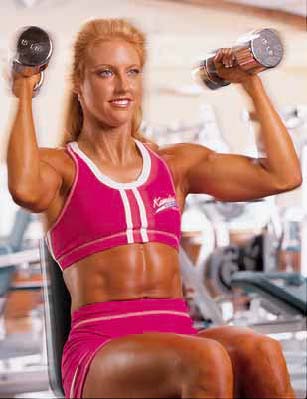|
DUMBBELLS ARE WELL-SUITED
for working the delts, making shoulders
the perfect at-home workout. Here, we build a workout around
three unique and very effective moves advocated by top IFBB
fitness competitor and model Beth Horn.
>>
Control is vital in this routine. Don’t throw the weights
around — perform the up and down slowly and deliberately.
>>
Don’t dawdle. To finish in 15 minutes or less, you’ll need
to keep rest periods to about 30 seconds max between sets.
|
|
#3 |
|
EXERCISE |
SETS
|
REPS
|
|
Palms-Facing Overhead
DB Press
|
3
|
10 |
DB Lateral Raise–
Horizontal Shoulder
Adduction |
3 |
12 |
Incline Cross-Body
Rear Delt Raise |
3 |
10–12 |
|
 |
 |
|
PALMS-FACING
OVERHEAD
DUMBBELL PRESS
START: Sit
upright, upper arms parallel to the floor, elbow
joints bent 90 degrees and feet planted firmly on
the floor.
MOVE:
Keeping your shoulders back and abs tight, extend
your elbows to press the dumbbells overhead,
maintaining a constant distance between the weights
throughout the ascent. The range of motion is less
than when the palms face forward, but it’s more
natural, Beth says. For example, you don’t
experience that “popping” sensation near the top of
the press, which is what often happens in the
shoulder’s ball-and-socket joint when you complete a
palms-forward rep.
|
|
|
|
|
DUMBBELL LATERAL RAISE–
HORIZONTAL SHOULDER
ADDUCTION
START: “In the
start position, I hold two dumbbells at my sides at
arms’ length, palms facing in,” Beth says.
“Maintaining a slight bend in my knees and waist to
keep pressure off my low back, I lean forward very
slightly.”
MOVE:
Raise the dumbbells directly out to your sides,
keeping your elbows bent 5–10 degrees. Stop once
your arms are parallel to the floor, and bring the
dumbbells together in front of you while keeping
your arms parallel to the floor, an active range of
motion called horizontal shoulder adduction. Once
your arms are extended directly out in front of you
and the weights are only a few inches apart, retrace
that movement to return to the top point of the
lateral raise: arms out to the sides, elbows
slightly bent. Then lower the weights back down to
your sides.
|
 |
|
 |
INCLINE
CROSS-BODY
REAR DELT RAISE
START: Set an incline
bench at 30–40 degrees and lie on the long pad so that one
side of your body is flush against it. Position your
non-working arm so that the lower half supports your head;
position your working arm, dumbbell in hand, to hang across
your body, your elbow slightly bent and your palm down.
MOVE:
Contract your shoulder to lift the dumbbell upward, keeping
your upper arm moving through the same diagonal plane
throughout, so that it always forms a 90 degree angle with
your torso. Retrace the movement back to the start position.
|
| |
Source:
One
of the
magazines of MUSCLE
& FITNESS
|
| |
|
|